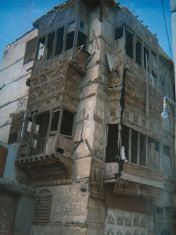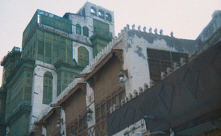During our childhood, we all dreamed of being Aladdin, to be a part of the fabulous 1001Arabian Nights tales, wishing to be there when it happened. The closest place one can get is “Balad” – literally translated as “The Town”, a part of Old Jeddah. Balad attracted me the very first time I saw it. It was evening, the sun slowly slipping into the Red Sea and as night tries to spread darkness, Balad, with its narrow stone topped lanes, treaded by travelers and traders for centuries, comes to life showcasing a vibrant market place teeming with street hawkers shouting to get the attention of bystanders, which reminded me of the crowded market streets back in India, giving me a feeling of being at home. To a tourist, it is confusing as you are jostled and pushed along by the massive crowd, if you are not sure of where you are going.

A typical house with latticed windows
![]()
I decided to come back the next day for a more leisurely exploration. The morning was quiet and cool as I started crisscrossing the lanes, stopping to have a closer look at the centuries-old multi-storied buildings. Almost all the buildings house shops in the ground floor and residential quarters in the upper floors. The architecture of the buildings is unique for this region in that they are built mainly from rectangular mud bricks or cut stones. The lower portions of the walls are made of stone bricks while the mud bricks are predominantly used in the upper walls with latticed wooden poles placed horizontally running the entire length of the walls every 4 to 5 feet height. This different architecture tickled my engineering brain to think of the advantages offered by this method of construction. Wood is flexible in compression and distributes the load evenly to the lower bricks, also effectively stopping any cracks in the wall developing beyond them, which makes repair work easier in addition to increasing the life of the building. The engineering mind of the medieval Arabs could be easily gauged by looking at these beautifully constructed multi-storied buildings, which has withstood the ravages of time and harsh environment of Arabia.
As I walked through the silent lanes of Balad, my mind flew backward in time to think about the history of Jeddah. Present day Jeddah came into existence as a fishing village when the “Quadaa” fishermen tribe settled 2500 years ago. Jeddah’s natural harbor and reef offered good fishing. The city grew into an important trading outpost as it was situated on the trading routes between Yemen and Europe. The city was fortified with limestone coral walls as early as 1000 AD, which was recorded by noted traveler, Nasir-I-Kusuro. The earlier fortification had two gates, one facing the east towards Mecca and the other towards the sea. The fortification was strengthened in the 16th century to protect the city from the Portuguese attack with six watchtowers and gates. The gate Bab Makkah faces East, Bab Sharif faces South, Bab Al Bunt, Bab Sharaf and Bab Al Madinah face North, and Bab Al Magharibah face west. The turbulent history of Jeddah saw it come under the rule of the Turkish Ottoman Empire, Egypt’s Mamalukes and Saudi’s of Central Arabia until the Saudi King Abdul Aziz took over the Western province of Hejaz, including the city of Jeddah. The King Abdul Aziz Historical Square, which is at the heart of the Balad, is where the people of Jeddah welcomed King Abdul Aziz and his army on the 23rd of September 1924. This day of annexing the Hejaz province is celebrated as National Day in Saudi Arabia.

A crumbling house with carved wooden rowasheen
![]() As I was giving my newly acquired camera a workout, shooting the old buildings exhibiting highly carved and turquoise exterior walls, some awaiting reconstruction and others crumbling down unable to withstand the test of the time, an elderly Arab called me and said something in Arabic, which was beyond my comprehension. Aware of the fact that Arabs do not like visitors to take photos in public places, I packed my gear and started to leave the place. He followed me and caught my hand and tugged me – now the worst fear of any foreigner in Arabia, offending the local culture, which could potentially land you in jail, even on a verbal complaint by the locals. I was perplexed, and started to sweat, even in the cool December weather.
As I was giving my newly acquired camera a workout, shooting the old buildings exhibiting highly carved and turquoise exterior walls, some awaiting reconstruction and others crumbling down unable to withstand the test of the time, an elderly Arab called me and said something in Arabic, which was beyond my comprehension. Aware of the fact that Arabs do not like visitors to take photos in public places, I packed my gear and started to leave the place. He followed me and caught my hand and tugged me – now the worst fear of any foreigner in Arabia, offending the local culture, which could potentially land you in jail, even on a verbal complaint by the locals. I was perplexed, and started to sweat, even in the cool December weather.
I was becoming nervous, and tried to free my hand from his grip. Sensing my anxiety he said “Taal, sadiq, taal”, which, based on my vocabulary of only a handful of Arabic words acquired in my past seven months of stay in Saudi Arabia, translates into “Come, friend, come.” Upon hearing the word friend, I felt a little ease as I was led to his house. I was offered dates and traditional Arabian coffee, quawa, over which we had some sort of conversation, he in Arabic and I in English and more animated action spread in between. He was kind enough to permit me to visit the first floor of his house, from where I had an insider’s view from the latticed and carved woodwork windows called “rowasheen” that allow air and light through the balcony while blocking the direct sunlight, heat and prying eyes from outside. Bidding farewell to my new friend, the rough and tough image of the Arabs, which have been built by the international media and expat’s stories, exploded inside me as it dawned on me that people all over are basically good, and one should not believe the artificially created images.

A six floor building with wooden windows
![]()
Balad is one big marketplace that contains many specialized markets such as Souq Al Nada, showcasing glittering and eye catching Arabian, African and Asian designed gold and silver ornaments; a textile market, Souq Al Jamia, named after the Bedouin tribes who used to sell textiles, spices, grains at this place; the Souq Al Alawi, which cuts through Balad from East to West; and the Gabel Street Souq, which sells an assorted variety of wares including spices, electronics, perfumes, dates, honey and household articles.
When you walk through the Souq Al Alawi, an impressive restored building called Biet Nassif, catches your eyes and entices you to come in. It has a 700-year-old flag mast and a 15th century cannon in its front yard that dominates the King Abdul Aziz Historical Square. The Jeddah Historical Area Preservation Department (JHAPD) restored Biet Nassif during the 1990s and it presently houses a cultural center. JHAPD has, over the last few years, restored a number of old and crumbling traditional buildings as the government protects all old buildings from demolition in order to preserve the historical area. The excavation of a 15th century underground water canal brings water from nearby mountains about 15 kilometers away, and underlines the historical and archaeological wealth waiting to be uncovered in Balad.
On the sides of Biet Nasssif is the Al Alawi Moroccan Restaurant, aesthetically located in a restored building with beautifully laid colorful stones on the front yard, creating a mystical medieval environment for diners wishing to taste traditional Moroccan and African cuisine. It came as a mild shock to be confronted by glittering high-rise buildings, shopping malls and ear piercing horns of cars as I exited the marketplace of Balad, awakened from my short travel in a time machine to my own Arabian night dreamland.
Questions?
If you want more information about this area you can email the author.